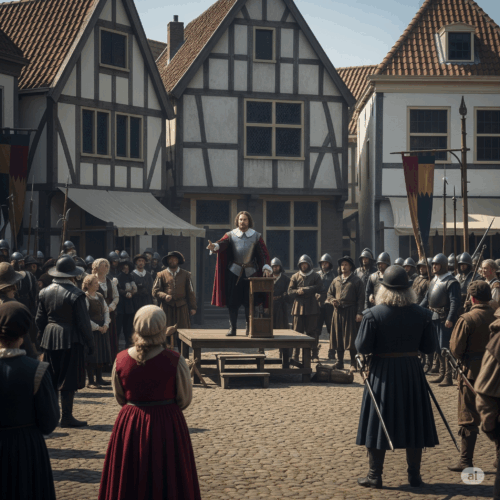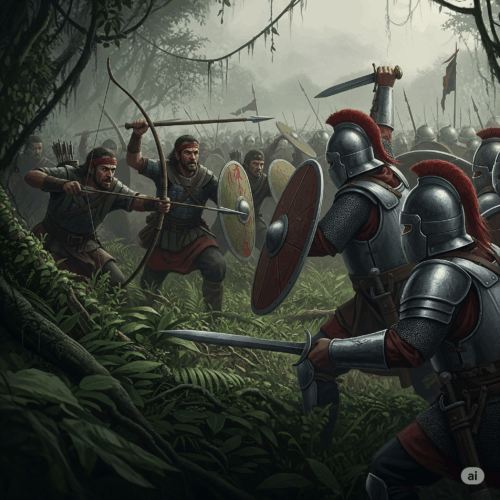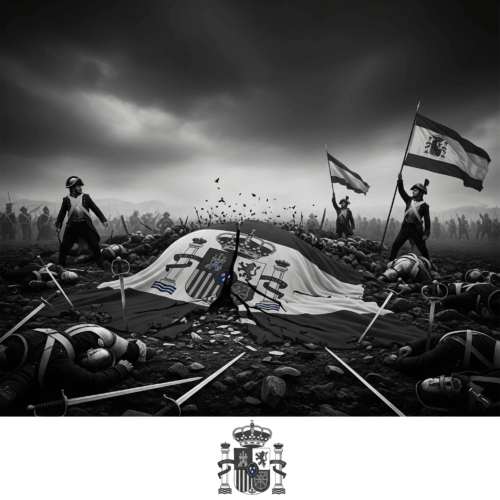May 19th. A date like any other? Or a portal to understanding ourselves and the world we navigate? Today, we delve into the annals of distant history, unearthing a truly significant event that transpired on this very day centuries ago. It’s a tale of ambition, conflict, strategy, and ultimately, a profound shift in power. But more than just a history lesson, we’ll explore how the echoes of this momentous occasion can offer surprisingly potent wisdom for your individual life in the 21st century. Prepare to see how the currents of the past can help you steer your own ship with greater clarity and purpose.
On May 19th, 1568, a pivotal and often overlooked naval engagement took place: the Battle of Heiligerlee. While perhaps not as universally recognized as Trafalgar or Midway, this battle, fought in the murky waters of what is now the Netherlands, was a crucial early victory for the Dutch rebels in their long and arduous struggle for independence from Spanish rule – the Eighty Years’ War. It wasn’t the largest battle, nor the most decisive in the grand scheme of the entire war, but its significance lies in its timing, its psychological impact, and the lessons it imparts about courage, initiative, and the power of challenging an established, seemingly insurmountable force.
To truly grasp the weight of this event, we must first paint a picture of the world in 1568. The mighty Spanish Empire, under King Philip II, was the undisputed superpower of the age. Its territories spanned the globe, its coffers were filled with New World gold, and its armies were the most formidable in Europe. The Netherlands, then known as the Seventeen Provinces, were a wealthy and industrious part of this empire, but discontent had been simmering for years. Religious persecution of Protestants by the staunchly Catholic Philip, coupled with heavy taxation and the erosion of local autonomy, fueled a growing desire for freedom.
The Duke of Alba, dispatched by Philip II with a formidable army of 10,000 men, had instituted a reign of terror known as the “Council of Troubles” (or “Council of Blood” to its detractors) to crush the burgeoning rebellion. Executions were rife, dissent was brutally suppressed, and an air of fear permeated the Low Countries. The Dutch rebels, led by figures like William of Orange (also known as William the Silent), were a disparate group, lacking the resources and unified command of their Spanish overlords. Early attempts at organized resistance had largely failed. Hope, for many, was a dwindling commodity.
It is against this backdrop of oppression and nascent, struggling rebellion that the Battle of Heiligerlee unfolds. Louis of Nassau, William of Orange’s younger brother, a charismatic and capable military leader, had managed to gather a small rebel army. His forces were a motley crew – German mercenaries, Dutch volunteers, and French Huguenots – bound together more by a shared desire to resist Spanish tyranny than by uniform training or equipment. Their numbers were modest, perhaps around 4,000 infantry and a few hundred cavalry.
Their opponents were a seasoned Spanish force, part of the Duke of Alba’s larger army, commanded by Jean de Ligne, Duke of Arenberg, the loyalist stadtholder of the northern provinces. Arenberg’s contingent, though perhaps slightly outnumbered in this specific engagement (estimates vary, but they were comparable in size or slightly smaller than Louis’s force), possessed the aura of Spanish invincibility and the discipline of professional soldiers. They were confident, perhaps overly so.
The strategic situation was tense. Louis of Nassau had invaded the northern province of Groningen, hoping to incite a broader revolt and secure a base of operations. Arenberg was dispatched to intercept and destroy him. The marshy terrain of Groningen, crisscrossed by canals and bogs, was not ideal for traditional European warfare, which often favored large, open-field battles. This, however, would play to the rebels’ advantage.
Louis, understanding his army’s limitations and the nature of the landscape, chose his ground carefully near the monastery of Heiligerlee. He positioned his troops strategically, using the terrain to offset the Spaniards’ potential advantages in open combat. He reportedly laid an ambush, a tactic often favored by commanders facing a superior or more conventional foe.
On that fateful May 19th (though some sources cite May 23rd, May 19th is a frequently noted date for the initial skirmishes and maneuvering that led to the main battle), the two forces clashed. The details of the battle are somewhat obscured by the mists of time and partisan accounts, but the general consensus is that the Spanish, perhaps underestimating the rebels or goaded by their perceived impudence, advanced aggressively.
Arenberg himself was reportedly eager for a decisive confrontation. Some accounts suggest that his cavalry, spotting what they believed to be a retreating or disorganized rebel force, charged forward without proper reconnaissance or support from their infantry. This impetuousness, if true, played directly into Louis of Nassau’s hands.
The rebels, concealed or strategically positioned, sprung their trap. The Spanish vanguard, caught off guard and struggling with the difficult terrain, found themselves assailed from unexpected quarters. The fighting was fierce and brutal. Musketry, pike formations, and the clash of steel defined the encounter. Despite their renowned discipline, the Spanish soldiers found their cohesion breaking down under the surprise attack and the challenging environment.
A key moment in the battle was the death of the Spanish commander, the Duke of Arenberg. Accounts differ on how exactly he fell – some say in a cavalry charge, others in the general melee. His demise, however, had a significant impact on the morale and command structure of the Spanish forces. With their leader gone and the tide of battle turning against them, the Spanish lines began to waver and then break.
The rebels pressed their advantage, and what began as an engagement turned into a rout. The Spanish forces suffered heavy casualties, with estimates ranging from 1,500 to 2,000 killed, wounded, or captured. The rebels, while also sustaining losses (including Louis’s younger brother, Adolf of Nassau, who died heroically), had secured a stunning and unexpected victory. They captured Spanish artillery and supplies, further bolstering their cause.
The Outcome and Its Immediate Significance:
The Battle of Heiligerlee was, in military terms, a relatively small affair compared to the grand battles that would follow in the Eighty Years’ War. It did not, by itself, secure Dutch independence. In fact, the Duke of Alba, enraged by the defeat, soon retaliated, defeating Louis of Nassau decisively at the Battle of Jemmingen just two months later.
However, the true significance of Heiligerlee lay not in its immediate strategic gains, but in its profound psychological and symbolic impact:
- Breaking the Myth of Invincibility: For years, the Spanish military machine had seemed unstoppable. Heiligerlee proved that Spanish tercios, the elite infantry units, could be beaten. It showed that a determined, well-led, and strategically astute rebel force could overcome the might of the empire, even if only locally and temporarily. This was a massive morale booster for the Dutch rebels and a seed of doubt planted in the minds of the Spanish.
- Fueling the Rebellion: The victory, however short-lived its direct military consequences, provided crucial impetus to the wider revolt. It demonstrated that resistance was possible and that success, however difficult, could be achieved. It likely encouraged more people to join the cause or at least to believe in its viability.
- A Warning to Spain: While Alba’s subsequent victory at Jemmingen restored Spanish military dominance for a time, Heiligerlee served as an early warning that the pacification of the Netherlands would be a far more costly and protracted affair than Philip II might have initially anticipated. It signaled the depth of Dutch resolve.
- Martyrdom and Legend: The death of Adolf of Nassau, fighting alongside his brother for the cause of freedom, created a martyr figure that further galvanized Dutch sentiment and became enshrined in their national narrative and even their national anthem, the “Wilhelmus.”
The Battle of Heiligerlee, therefore, was a spark. It was a defiant cry in the face of overwhelming power, a testament to the impact of bold leadership, strategic thinking, and the courage to fight for one’s convictions even when the odds seem stacked against you. It was one of the first drops in a rainstorm that would eventually erode the foundations of Spanish rule in the Netherlands and lead to the birth of a new, independent Dutch Republic – a nation that would, in time, become a major economic and cultural power itself.
Applying the Wisdom of Heiligerlee to Your Life Today:
So, how can a nearly 460-year-old battle in a distant land offer any relevant wisdom for your life in the 21st century? The connection might seem tenuous at first, but the underlying principles and human dynamics at play in Heiligerlee resonate surprisingly powerfully with the challenges and opportunities we face as individuals today.
Let’s break down the key lessons and how you can apply them to achieve personal growth, overcome obstacles, and live a more fulfilling life:
- Challenging Your “Spanish Empire”: The Power of Questioning Dominant Narratives
- Historical Context: The Dutch rebels were up against the Spanish Empire, an entity that represented established authority, overwhelming power, and a seemingly unshakeable status quo. To even conceive of challenging this was an act of immense courage and a rejection of the prevailing narrative of Spanish invincibility.
- Modern Application: In your life, what are your “Spanish Empires”? These could be:
- Limiting Beliefs: Deep-seated assumptions about your capabilities, your worth, or what’s possible for you (“I’m not smart enough,” “I’ll never be successful,” “People like me don’t do things like that”). These are often narratives imposed by upbringing, society, or past failures.
- Societal Expectations: The “shoulds” and “oughts” that dictate career paths, lifestyle choices, or measures of success, even if they don’t align with your authentic desires.
- Comfort Zones: The routines, habits, and environments that feel safe but ultimately stifle growth and prevent you from pursuing your true potential.
- External “Authorities”: Sometimes, these can be specific people or institutions whose opinions you’ve allowed to hold too much sway over your decisions, even if their advice isn’t in your best interest.
- The Heiligerlee Approach:
- Identify the “Empire”: Become consciously aware of the dominant narratives or limiting beliefs that are holding you back. Journaling, introspection, and honest conversations with trusted friends or mentors can help.
- Question its Invincibility: Just as Heiligerlee showed Spain wasn’t unbeatable, critically examine the “truth” of these limiting beliefs. Are they based on objective fact, or are they outdated assumptions or fears? Seek counter-evidence.
- Dare to Dissent: Give yourself permission to want something different, to believe something different, even if it goes against the grain. The Dutch rebels didn’t wait for permission to desire freedom.
Benefit: By consciously identifying and challenging your internal and external “Spanish Empires,” you liberate yourself from self-imposed constraints. This opens up new possibilities for action, growth, and a life lived more authentically, rather than one dictated by fear or outdated programming. You create space for your own “rebellion” against mediocrity or unhappiness.
- The “Heiligerlee Strategy”: Leveraging Your Unique Strengths and Asymmetric Warfare
- Historical Context: Louis of Nassau knew he couldn’t defeat the Spanish in a conventional, open-field battle where their superior numbers, training, and resources would prevail. Instead, he chose his ground carefully (the marshy terrain), used unconventional tactics (the ambush), and capitalized on the enemy’s weaknesses (their potential overconfidence and the disruption caused by the terrain). This was a form of asymmetric warfare – not meeting strength with strength, but with cunning and strategic advantage.

- Modern Application: You don’t always have to confront your challenges head-on with brute force, especially if you feel outmatched. Instead, think like Louis of Nassau:
- Know Your Terrain (Your Strengths and Weaknesses): What are your unique talents, skills, and passions? What are your inherent limitations or areas where you struggle? Be brutally honest with yourself.
- Identify the “Enemy’s” Weaknesses (The Nature of Your Obstacle): What are the vulnerabilities in the problem you’re facing? If it’s a career challenge, perhaps the traditional route is saturated, but a niche approach is open. If it’s a personal habit, perhaps a direct confrontation fails, but a gradual change or a system of accountability would work.
- Choose Your “Battleground” Wisely: Don’t engage in battles you’re unlikely to win. Instead, create or find environments and situations where your strengths are amplified and your weaknesses are minimized. If you’re an introvert trying to network, massive conferences might be draining, but smaller, focused gatherings or one-on-one meetings could be your “Heiligerlee.”
- Employ “Ambush” Tactics (Creative and Unconventional Solutions): Think outside the box. If the standard approach isn’t working, what’s a different angle? This could mean learning a new skill, leveraging technology in an innovative way, or reframing the problem entirely.
- The Heiligerlee Approach in Action:
- Career: Instead of competing for a highly sought-after job with thousands of similar applicants, perhaps you leverage your unique combination of skills to create a new role for yourself or start a niche business.
- Personal Goals: Trying to write a novel by forcing yourself to write 2,000 words a day might lead to burnout. Perhaps your “Heiligerlee strategy” is to join a writer’s group for accountability, use voice-to-text software to overcome a mental block, or focus on short bursts of writing during your peak energy times.
- Problem Solving: Faced with a complex interpersonal conflict? Instead of direct confrontation (which might be your “Spanish open field”), perhaps a mediated conversation, a carefully worded letter, or addressing the issue indirectly through a third party is your strategic “ambush.”
Benefit: By applying the Heiligerlee strategy, you stop wasting energy fighting losing battles. You learn to work smarter, not just harder, by leveraging your unique advantages and finding creative pathways to success. This approach fosters innovation, resilience, and a sense of agency, even when facing seemingly insurmountable odds.
- The Courage of Conviction: The Adolf of Nassau Factor
- Historical Context: The rebels at Heiligerlee, including leaders like Louis and his brother Adolf, were fighting for something they deeply believed in: freedom from oppression, religious tolerance, and self-determination. Adolf of Nassau paid the ultimate price for this conviction, dying in battle. This commitment, even in the face of extreme danger, was a powerful motivator.
- Modern Application: What are your core values and deepest convictions? What are you willing to truly stand for, even when it’s difficult or unpopular?
- Define Your “Why”: Understanding your fundamental motivations is crucial. Why do you want to achieve that goal? Why is that change important to you? Connecting your actions to a deeper sense of purpose fuels resilience.
- Align Actions with Values: Are your daily choices and long-term goals in harmony with what you profess to believe? Dissonance here can lead to dissatisfaction and a lack of motivation.
- Embrace “Noble Sacrifice” (Not Necessarily Literal!): The “sacrifice” in modern life is often about forgoing immediate gratification for long-term gain, stepping out of your comfort zone, investing time and effort in something meaningful, or standing up for your principles even when it means facing criticism or risking disapproval.
- Find Your “Band of Rebels”: The Dutch rebels were not alone. They had comrades who shared their convictions. Surrounding yourself with people who support your values and goals can provide immense strength and encouragement.
- The Heiligerlee Conviction in Practice:
- Making Ethical Choices: Standing by your ethical principles in your career, even if it means forgoing a lucrative but morally questionable opportunity.
- Pursuing Passion Projects: Dedicating time and energy to a creative endeavor, a community service, or a personal development goal that deeply resonates with you, even if it doesn’t offer immediate external rewards.
- Advocating for Others: Using your voice or resources to support causes or people you believe in.
Benefit: Living a life aligned with your deepest convictions brings a profound sense of integrity, purpose, and fulfillment. Like the rebels who drew strength from their cause, you will find an inner resilience to overcome setbacks and persevere through challenges. This intrinsic motivation is far more powerful and sustainable than purely external drivers like money or status.
- The Ripple Effect of Small Victories: Heiligerlee’s Psychological Win
- Historical Context: Militarily, Heiligerlee was soon overshadowed. But psychologically, it was a watershed. It proved that victory was possible. This small win had a disproportionately large impact on rebel morale and the broader perception of the conflict.
- Modern Application: Don’t underestimate the power of small wins in your own life. We often focus on massive, life-altering transformations and get discouraged when they don’t happen quickly.
- Break Down Big Goals: Instead of being overwhelmed by a huge objective (e.g., “get healthy,” “write a book,” “change careers”), break it down into smaller, manageable steps – your personal “Heiligerlees.”
- Celebrate Each “Battle” Won: Acknowledge and celebrate your progress along the way. Did you go to the gym three times this week? Did you write 500 words? Did you research one new career path? These are victories!
- Build Momentum: Small wins create a positive feedback loop. They build confidence, reinforce good habits, and make the next step seem less daunting. This momentum can carry you through more challenging phases.
- Shift Your Mindset: Focus on progress, not just perfection. Each small step forward is a move away from the “Spanish stronghold” of your old habits or limitations.
- The Heiligerlee Momentum Strategy:
- Fitness: Start with a 10-minute walk daily, not a marathon. Celebrate that consistency.
- Learning a New Skill: Dedicate 15 minutes a day to practice. Each session is a small win.
- Decluttering Your Home: Tackle one drawer or one shelf, not the whole house at once.
Benefit: Recognizing and celebrating small victories keeps you motivated, reduces overwhelm, and builds a sustainable path toward your larger goals. It transforms daunting mountains into a series of manageable hills, each one conquered providing the strength and encouragement to tackle the next. This is how lasting change is built, one “Heiligerlee” at a time.
- Adaptability and Learning from Setbacks: The Post-Heiligerlee Reality
- Historical Context: The joy of Heiligerlee was short-lived for Louis of Nassau. The Duke of Alba’s forces crushed him at Jemmingen just two months later. However, the broader Dutch Revolt did not die. The rebels learned, adapted, and continued their fight for decades, eventually achieving their independence. Setbacks were part of the journey, not the end of it.
- Modern Application: You will face setbacks. Your “Heiligerlee” victories might be followed by “Jemmingen” defeats. The key is not to avoid failure, but to learn from it and adapt.
- Embrace Failure as Feedback: Every setback contains valuable information. What went wrong? What could you do differently next time? Don’t let failure define you; let it refine you.
- Cultivate Resilience: The ability to bounce back from adversity is crucial. This involves acknowledging your disappointment but not dwelling in it, and then refocusing on your goals with renewed determination.
- Be Flexible and Adaptable: Sometimes, the original plan no longer works. Like the Dutch who had to constantly change their strategies over 80 years, be willing to pivot, adjust your approach, and find new ways forward. Rigidity is the enemy of long-term success.
- Maintain Long-Term Vision: Even after Jemmingen, the dream of Dutch independence remained. Keep your ultimate “why” in sight, even when immediate circumstances are discouraging.
- The Post-Heiligerlee Mindset:
- A project at work fails: Don’t blame others or give up. Analyze the reasons, extract the lessons, and apply them to your next endeavor.
- A personal goal is derailed: Reassess your strategy. Do you need more support? A different approach? Or just a break before trying again?
- You receive criticism: Instead of becoming defensive, try to understand the valid points (if any) and use them to improve.
Benefit: Viewing setbacks as learning opportunities rather than absolute failures builds resilience and fosters continuous improvement. This adaptive mindset allows you to navigate the inevitable ups and downs of life with greater grace and effectiveness, ultimately increasing your chances of achieving your long-term aspirations, much like the Dutch eventually won their “Eighty Years’ War.”
Conclusion: Your Own Heiligerlee Awaits
The Battle of Heiligerlee, fought on May 19th, 1568, was more than just a fleeting victory in a long war. It was a moment where the seemingly impossible became possible, where courage and strategy defied overwhelming odds, and where a small act of defiance sent ripples through history.
Its echoes reach us today, not as a dusty historical footnote, but as a vibrant source of wisdom. By understanding the principles that led to that surprising rebel victory, you can unlock powerful strategies for navigating your own life:
- Challenge the “Spanish Empires” of your limiting beliefs and societal pressures.
- Employ your own “Heiligerlee Strategy” by leveraging your unique strengths and tackling challenges with creativity.
- Find the “Courage of Conviction” that comes from aligning your actions with your deepest values.
- Harness the “Ripple Effect of Small Victories” to build momentum and stay motivated.
- Cultivate “Adaptability and Learn from Setbacks,” understanding that the path to success is rarely linear.
Your life is your own grand campaign. There will be formidable challenges, moments of doubt, and times when the “enemy” – be it internal or external – seems too powerful. But within you lies the capacity for strategic thinking, courageous action, and unwavering resolve, just like Louis of Nassau and his brave rebels.
Look for your “Heiligerlee” moments – those opportunities to challenge the status quo, to take a calculated risk, to achieve a small but significant victory that builds your confidence and propels you forward. The lessons from that marshy battlefield nearly five centuries ago are timeless. The power to apply them, to fight for your own “independence” from whatever holds you back, and to achieve outcomes that resonate with your deepest aspirations, lies within you, today and every day. May the echoes of Heiligerlee inspire you to win the battles that truly matter in your own remarkable life.

